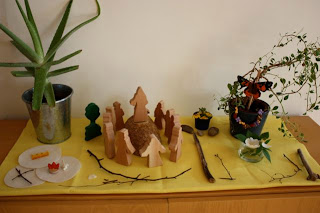The weather in Berlin has warmed up enough that our bi-weekly Family Brunch can meet in the park again. How wonderful it is to meet with God right in the middle of his wonderful creation! This week I combined two Young Children and Worship stories, "Jesus Commissions the Disciples" and "Ascension". Das Wetter in Berlin ist endlich schön geworden und wir dürften den Familien Brunch (ein Angebot von Haus Berlin e.V..) draußen im Park veranstalten. Es war wunderschön Gott mittendrin in seiner Schöpfung zu begegnen! Diese Woche habe ich zwei Geschichten von Young Children in Worship, "Jesus gibt seinen Jüngern einen Auftrag" und "Himmelfahrt", kombiniert.
The story time was actually a bit rough this week, because the children were so distracted by having church outside for the first time in a long time. But that was okay. It was exciting to be outside and who wouldn't be distracted by the adorable squirrels and cool bugs? Das Erzählen von der Geschichte ging ein bisschen schief diese Woche, da die Kinder so aufgeregt waren den Kindergottesdienst zum ersten Mal draußen nach dem langen Winter zu haben. Aber das war in Ordnung. Es war einfach toll im Park zu sein und wer hätte sich von den niedlichen Eichhörchen und faszinierenden Insekten nicht ablenken können?
The finished paintings made me smile! Die fertige Bilder haben mich total gefreut!
In the second activity the children used tongs to find and transfer acorn shells from a bowl of sand into the compartments of an ice cube tray. Bei der zweiten Aufgabe sollten die Kinder einen Pinzette benutzen um Eichlen vom Sand in eine Eiswürfelform zu übertragen
The older children who could read had the opportunity to put together the words of the Great Commission. The control card is in the bottom right hand corner. Die älteren Kinder konnten die letzen Worter, den Auftrag, von Jesus puzzeln. Die Kontrollekarte ist unten rechts.
The story time was actually a bit rough this week, because the children were so distracted by having church outside for the first time in a long time. But that was okay. It was exciting to be outside and who wouldn't be distracted by the adorable squirrels and cool bugs? Das Erzählen von der Geschichte ging ein bisschen schief diese Woche, da die Kinder so aufgeregt waren den Kindergottesdienst zum ersten Mal draußen nach dem langen Winter zu haben. Aber das war in Ordnung. Es war einfach toll im Park zu sein und wer hätte sich von den niedlichen Eichhörchen und faszinierenden Insekten nicht ablenken können?
One of the activities that the children could choose from in the Creative Phase was the Ascension Art Project that I wrote about in my last post. In addition to the artistic aspect, this project involved counting (the children had to make 11 dots for the 11 disciples and 2 white dots for the two angels) and recognition of emotions (I asked the children to imagine how Jesus' friends felt when he left them and if they were happy, sad, surprised, angry, etc.). Während der Kreativphase gab es mehrere Möglichkeiten. Eins davon war das Kunstprojekt zu Himmelfahrt, die ich im letzen Post gezeigt habe. Zusätzlich zu dem kreativen Aspekt, konnten die Kinder die Zahlen üben, indem sie 11 Püntkchen für die Jünger und 2 für die Engel malen mussten. Auch habe ich die Kinder gefragt, wie die Jünger sich gefühlt haben als Jesus plötzlich weg war. Das war eine gute Gelegenheit für die Kinder unterschiedliche Emotionen und Ausdrücke zu überlegen.
 |
| Painting the mountaintop. Ein Kind malt den Hintergrund. |
 |
| Drawing the disciple's reactions to Jesus' ascension with a felt-tipped pen. Dieses Kind malt die Reaktionen der Jünger mit einem Filzstift. |
The finished paintings made me smile! Die fertige Bilder haben mich total gefreut!
I set up two Montessori Practical Life activities for the children to choose from as well. The first one, pictured below, involved stringing buttons in the shape of ladybugs, butterflies, and other insects onto pipe cleaners. Es gab auch zwei Montessori Angebote vom Bereich, "Praktisches Leben". Bei der ersten unten sollten die Kinder Knöpfe in der Form von Marienkäfern, Schmetterlingen, und andern Insekten auffädeln.
In the second activity the children used tongs to find and transfer acorn shells from a bowl of sand into the compartments of an ice cube tray. Bei der zweiten Aufgabe sollten die Kinder einen Pinzette benutzen um Eichlen vom Sand in eine Eiswürfelform zu übertragen
The older children who could read had the opportunity to put together the words of the Great Commission. The control card is in the bottom right hand corner. Die älteren Kinder konnten die letzen Worter, den Auftrag, von Jesus puzzeln. Die Kontrollekarte ist unten rechts.
This was the first time that I have set up a focus table outside. It looked so beautiful surrounded by the plants in the park. Ich habe zum ersten Mal einen Fokustisch im Park aufgestellt. Mit den ganzen Pflanzen herum sah es hübsch aus.
Have a wonderful Ascension! We get the day off here in Berlin, so we are especially excited! Bis zum nächsten Mal!
Linked to The Magic Onions
Linked to The Magic Onions






























